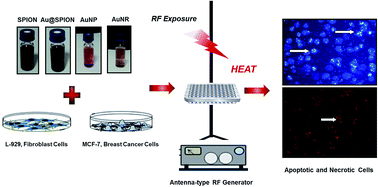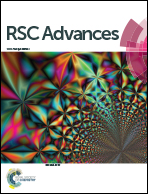Antenna-type radiofrequency generator in nanoparticle-mediated hyperthermia†
Abstract
Induction of hyperthermia using nanoparticles with specific magnetic, electrical, acoustic, optical or thermal properties is a potential alternative to conventional thermal ablation in cancer therapy. In this study, for the first time we employed an antenna-type radiofrequency (RF) generator as the energy source and as a proof of concept the effects of nanoparticles of varying structures and sizes, such as superparamagnetic iron oxide nanoparticles (SPIONs), gold-coated superparamagnetic iron oxide nanoparticles (Au@SPIONs), spherical gold nanoparticles (AuNPs), and gold nanorods (AuNRs) on RF hyperthermia were examined to determine hyperthermia efficiency of the antenna-type RF generator. In preliminary experiments, RF was applied at varying powers to various nanoparticle solutions. In all cases, temperature rises due to exposure of RF radiation to nanoparticles were captured by using an infrared thermal camera. This procedure was applied to in vitro tests of fibroblast (L-929) and breast cancer (MCF-7) cell lines. Cell viability, apoptosis and necrosis were evaluated in both cell lines to comprehensively determine cell toxicity. Due to their particle size and chemical nature, SPIONs, in the case of highest RF power and nanoparticle concentration, resulted in the lowest cell viability and highest levels of apoptosis and necrosis.


 Please wait while we load your content...
Please wait while we load your content...